“Mirror, Mirror”
Written by Jerome Bixby
Directed by Marc Daniels
Season 2, Episode 10
Production episode 60339
Original air date: October 6, 1967
Stardate: unknown
Captain’s log. Kirk is leading a landing party that includes McCoy, Scotty, and Uhura to negotiate with the Halkan Council over mining rights—which the Halkans are refusing. The Halkans have a history of total peace, and they cannot risk the Federation using the dilithium crystals to take even one life, as that would violate their ethics. Tharn, the head of the council, points out that they could take the dilithium by force, and Kirk smiles and says they won’t, and that he should consider that.
A nasty ion storm is buffeting the Enterprise in orbit, and Kirk orders the landing party beamed back and a course set to clear the storm. However, something goes wrong with the transport, and the landing party find themselves in the transporter room of a much different Enterprise. Everyone’s uniform is different, there’s a logo with a sword through an image of the Earth all over the place, four security guards stand at the transporter room door, and Spock has a Vandyke beard. Everyone gives Kirk a very formal salute upon their materialization.
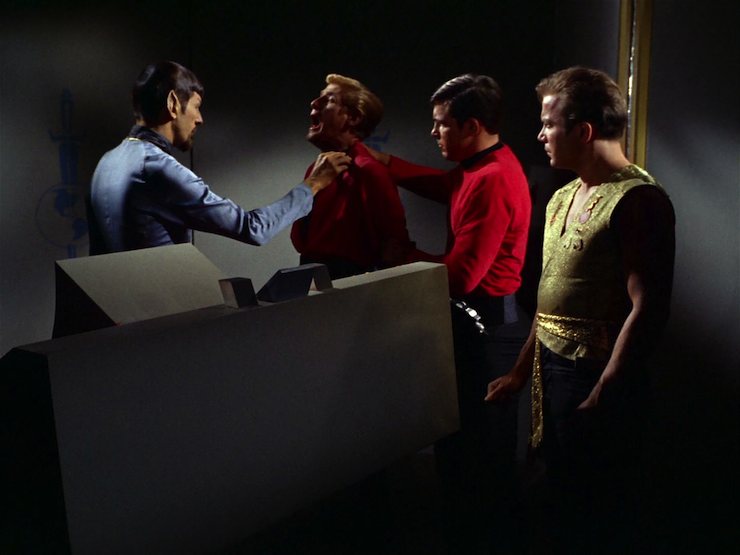
Spock asks for a status update, and Kirk neutrally says, “No change.” So Spock calls the bridge and orders Sulu to start phaser barrage on Halkan cities. Spock then disciplines Kyle for not operating the transporter properly, said discipline involving an agonizer, which personnel keep on their belts, and cause great pain when applied.
Kyle also reports that there was a power spike in the transporter like nothing he’d ever seen. Kirk snatches on that and says that McCoy had best examine all four of them in case there are any ill effects.
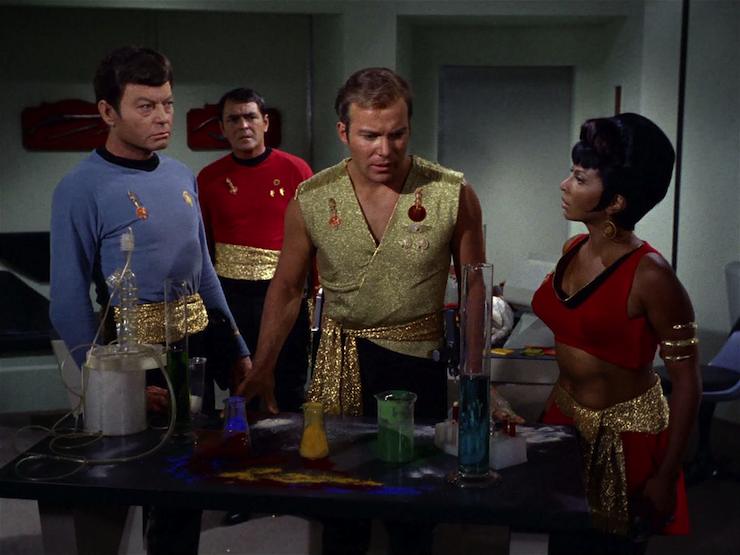
Once they’re safely in sickbay, they can talk openly, with Kirk having been saluted endlessly in the corridors en route. McCoy is appalled at sickbay, as everything is all rearranged and messed up—but the spot on the table where he spilled acid has the exact same acid stain on it. They go over what happened—they all remember briefly materializing in their own Enterprise at first, then fading and appearing in this parallel universe. They hypothesize that the alternate landing party was beaming up at the same time and they were exchanged—which means that their counterparts must be on their Enterprise.
Kirk sends Scotty to engineering to trash the phaser coupling and blame it on the ion storm, then figure out how to get them back home. He also sends Uhura to the bridge to go over Kirk’s communiqués from Starfleet Command and find out what his orders are and what his options are.
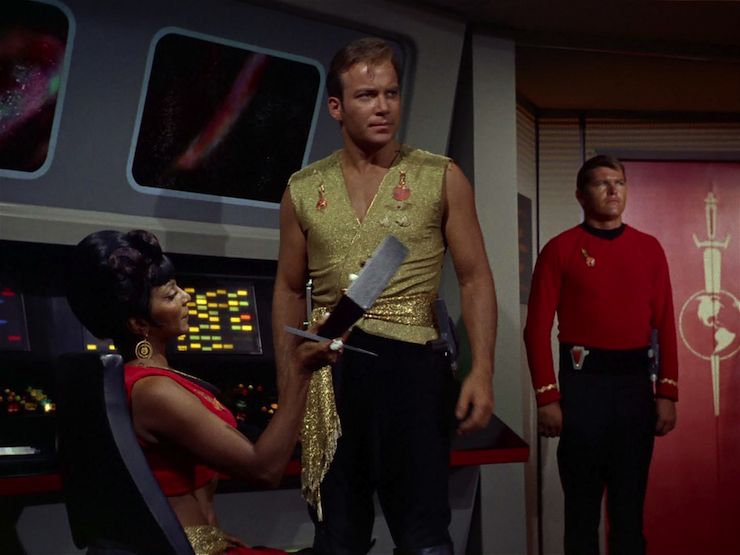
Uhura arrives on the bridge, which gets her a lascivious look from Sulu—who’s wearing security red rather than command gold, and who also has a scar on the left side of his face. Sulu wanders over to Uhura’s console to hit on her (starting with “Still no interest, Uhura?” so at least she’s spared having to pretend to reciprocate), which only ends when Kirk walks on the bridge, saluted by everyone. Uhura informs him that communications suffered no storm damage, and sotto voce she adds that Kirk’s only option is to eliminate the Halkans if they won’t cooperate.
Kirk then sits in his command chair, which is much comfier than his usual. Sulu announces that phasers are ready to fire on primary target, but Kirk orders Sulu to stand by. Unfortunately, Scotty can’t inspect the phaser controls without authorization from security, which, of course, Scotty can’t get.
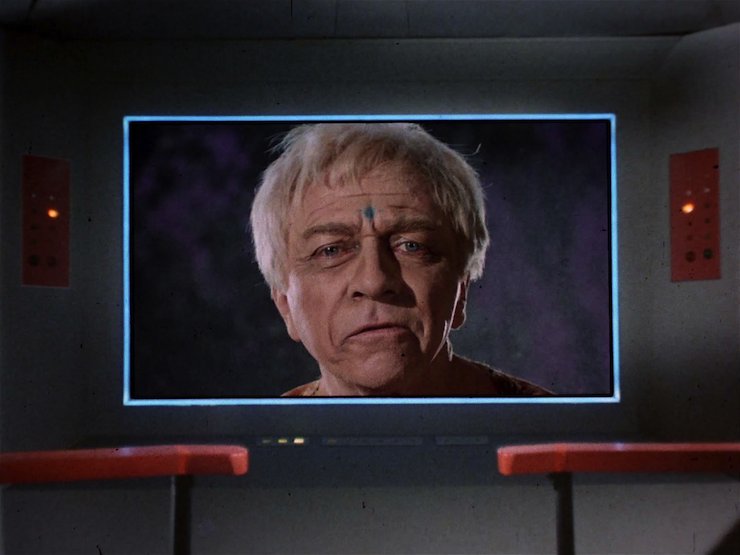
After Scotty reports to the bridge that there’s no damage, Kirk stalls by asking Uhura to contact the Halkan Council to talk to them again. Spock finds this odd, as they have already refused the Empire and must be punished. But Kirk insists.
This version of Tharn is far more haggard, and Kirk gives him twelve hours to change his mind. He then orders phasers shut down and announces that he’ll be in his quarters, and has Uhura order McCoy and Scotty to meet him there (Uhura gives him a “can I come with you?” look and Kirk gives a “there’s no way to justify taking you off the bridge” look back). Spock points out that Kirk’s bizarre behavior will have to be reported, which Kirk assuredly says Spock is at liberty to do.

While Kirk is giving orders, Chekov pushes two buttons on his console and joins Kirk in the turbolift. When they arrive on deck 5, Kirk is ambushed. Chekov plans to assassinate him, thus allowing everyone else to move up in rank. But Wilson, one of Chekov’s pet thugs, attacks Chekov instead, allowing Kirk to get the upper hand. By the time Kirk’s own pet thugs arrive, Chekov’s other two henchmen are dead and Chekov is unconscious. Wilson wants to work for Kirk, figuring that, while Chekov offered to make him a chief, Kirk could make him an officer. Kirk agrees to employ Wilson, then socks him in the jaw so he doesn’t get too uppity.
Kirk meets McCoy and Scotty at his quarters. McCoy reports that two of his staff were betting on how long it would take an injured crewperson to pass out from the pain of his injuries. Scotty says the technology, at least, is basically the same, even if the people aren’t.
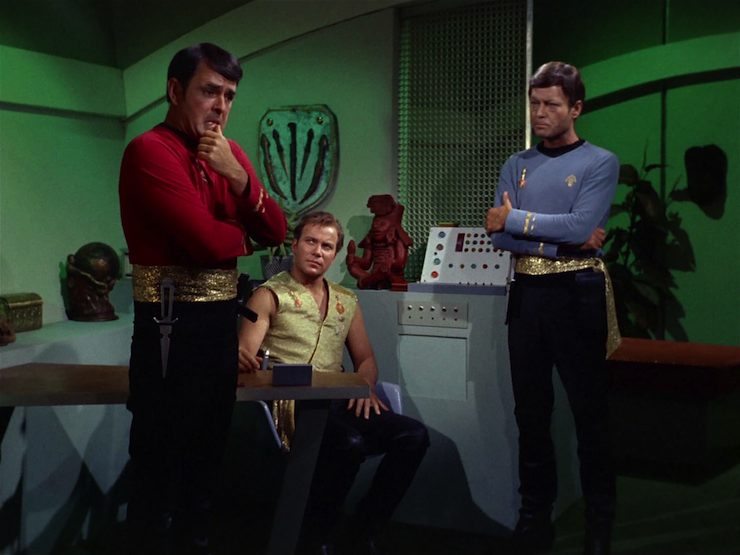
Kirk turns on the computer, which, instead of saying, “Working” in a pleasant female voice, says, “Ready” in a harsh male voice. After securing this computer session, to be accessible only by him or Scotty, he confirms that the mix of ion storm and transporter could result in a switch between parallel universes. The computer records the procedure for artificially re-creating those conditions and Scotty looks it over.
While he does so, McCoy muses on what kind of people they are. Kirk asks for “his” service record, learns that this Kirk took command by assassinating Pike and his first actions involved exterminating entire populations. Kirk cuts it off before it can go past his first two missions as captain.
Scotty can do it, although he’ll need help, and McCoy is volunteered to be his assistant. The only issue is that the transfer of power will show up on Sulu’s security board, so he’ll need to be distracted.
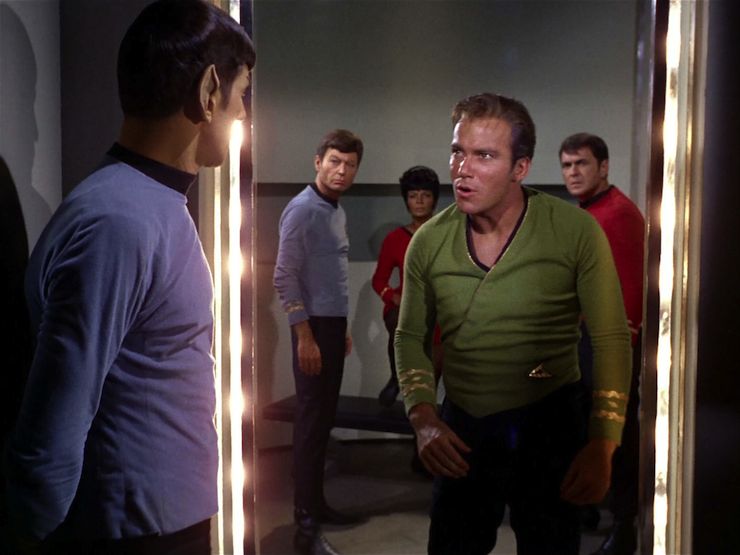
Meanwhile, back in the mainline universe, two security guards throw Kirk into the brig, where McCoy, Scotty, and Uhura already are. The foursome are rather confused by their changed uniforms, the weird behavior of everyone, and Spock’s lack of a beard. Spock finds the other Kirk’s offers of money and power to be fascinating and wanders off, leaving a confused, shouting Kirk behind in custody.
Back on the I.S.S. Enterprise, Spock—trailed by a Vulcan bodyguard—talks to Kirk. He says he’s pleased that Chekov’s assassination attempt failed, as he has no desire for command—he prefers the simpler duties of science officer, plus he’s less of a target where he is now. Chekov himself is in the agony booth being tortured. As they walk through the corridors—Kirk’s own bodyguard walking alongside Spock’s—they discuss the Halkan situation, and Kirk’s odd behavior.
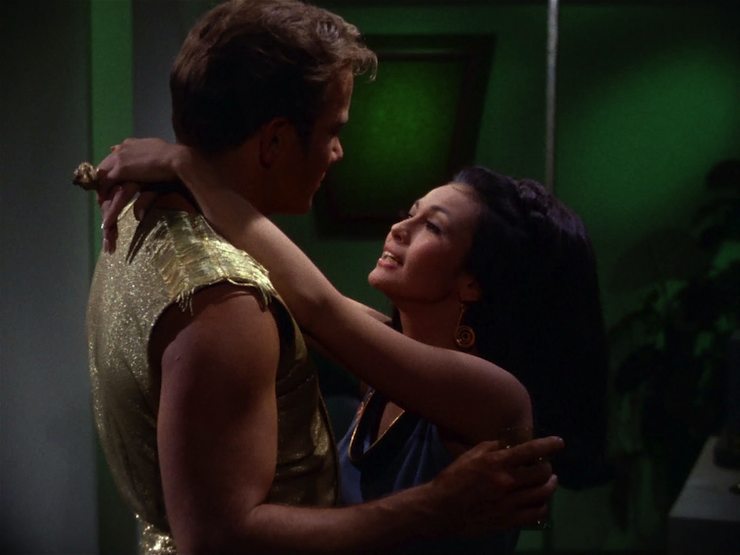
Scotty and McCoy go to engineering—a hypo of McCoy’s getting them past the security guard—while Kirk goes to his quarters to find a woman in his bed. This is Lieutenant Marlena Moreau, who works in the chemistry lab, and is also the Captain’s Woman. She wonders what he has planned, since sparing the Halkans is out of character, and she’s also surprised that he was caught off-guard by Chekov.
Spock then informs Kirk that he received a private message from Starfleet Command. He is violating regulations by informing Kirk of its contents: if Kirk hasn’t completed his mission by planetary dawn, Spock is to kill Kirk and take over as captain.
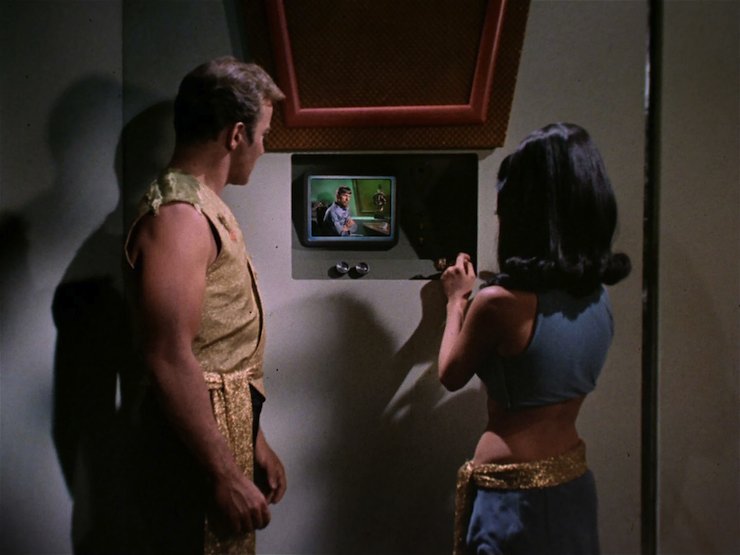
Moreau is impressed with Spock’s loyalty, especially since he’ll die for it. She activates the Tantalus Field, and Kirk soon learns that it’s a weapon that Kirk plundered from an alien laboratory that can make anyone simply disappear. She focuses the device on Spock and offers to kill him, but Kirk stops her.
After she departs, Kirk calls Scotty, saying they have a three-hour deadline, but Scotty informs him that it’s only half-an-hour because the initial exchange increased the field density between universes. Once it gets too big, they’ll never be able to switch back. In ten minutes, he’ll be ready, and Uhura will need to distract Sulu.
Spock detects a high level of computer activity in engineering, but when he queries the computer, it tells him that it’s voice-locked to Kirk and Scotty only. Spock’s computer then detects Sulu performing a security sweep on Spock’s communications, and the first officer angrily asks why he’s doing that. Sulu explains that he also detected the unusual computer activity—and he also can guess what Spock’s secret orders are. They verbally fence for a bit, Spock making it clear that his Vulcan operatives will avenge his death, which makes Sulu more than a little apprehensive.
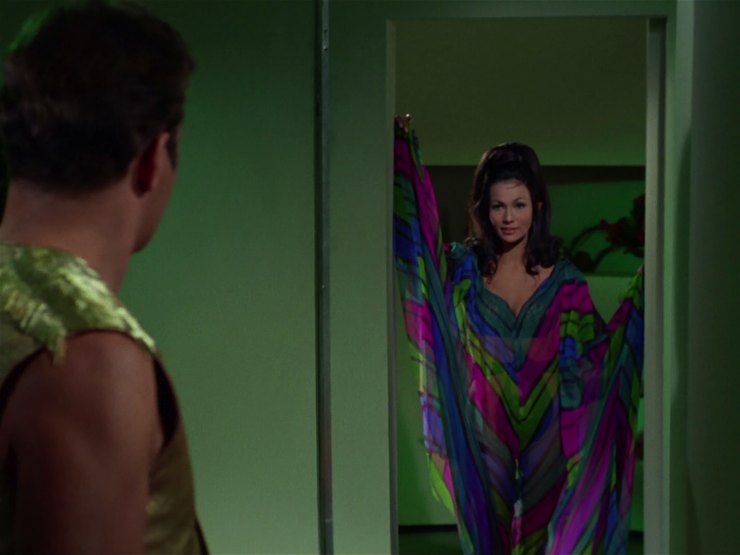
Moreau comes back, having changed into a sexy dress. Apparently, Kirk and Moreau’s relationship has grown stale, but Kirk’s charisma impresses her. However, when he excuses himself to go help Scotty with his sabotage, she assumes the relationship is over. But when he kisses her, it’s with significant passion, and Moreau realizes that this isn’t the Kirk she knows—he’s showing mercy. He also makes it clear that she’s the Captain’s Woman until he says she isn’t.
Then he heads to the transporter room. She goes to the Tantalus Field and trains it on Kirk.
Scotty signals Uhura to distract Sulu. She does so, giving in to his seduction long enough for his smooching her to keep him from noticing the alarm on his board. Once that’s done, she slaps him, saying she changed her mind again, and pulling a knife on him when he protests. She leaves the bridge and heads to sickbay. Scotty and McCoy do their part to transfer power, but Kirk’s accepting of the transfer in the transporter room is interrupted by Spock. He leads Kirk to sickbay at phaserpoint—the intent was to question McCoy, since he’s probably more susceptible to his interrogation techniques than Kirk, but he sees the whole landing party present. A fight ensues, and it takes all four of them to take Spock down.
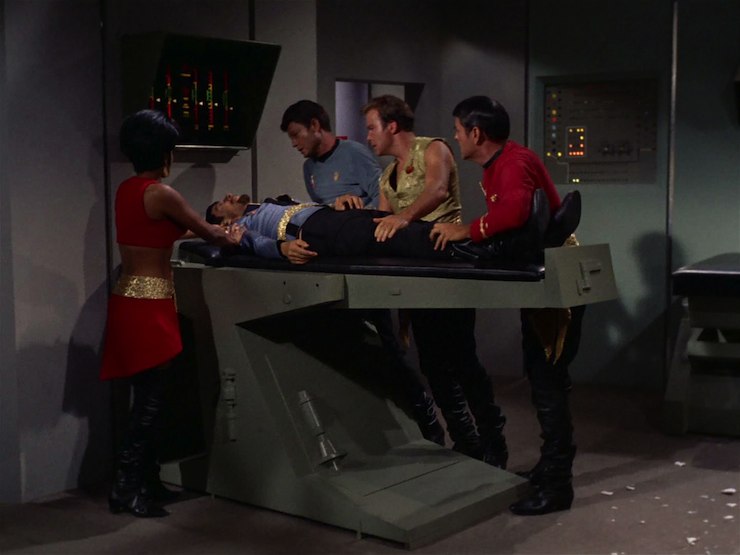
Scotty is ready to head to the transporter room, as they don’t have much time, but McCoy insists on treating Spock, as the head trauma they inflicted on him could kill him. Then they’re interrupted by Sulu and four of his guards. His plan is to assassinate Kirk and Spock both, setting it up so that it looks like they killed each other, leaving Sulu himself in command.
However, Moreau has been watching this all on the Tantalus Field, and she uses it to eliminate Sulu’s henchmen. Kirk himself takes Sulu out.
McCoy insists on treating Spock, so Kirk, Scotty, and Uhura go ahead to the transporter room. They find Moreau there. Kirk thanks her for saving their lives, and she asks that they take her with them in return. But they can’t, the transporter is only calibrated for four. She insists on going with her phaser, but then Uhura disarms her.
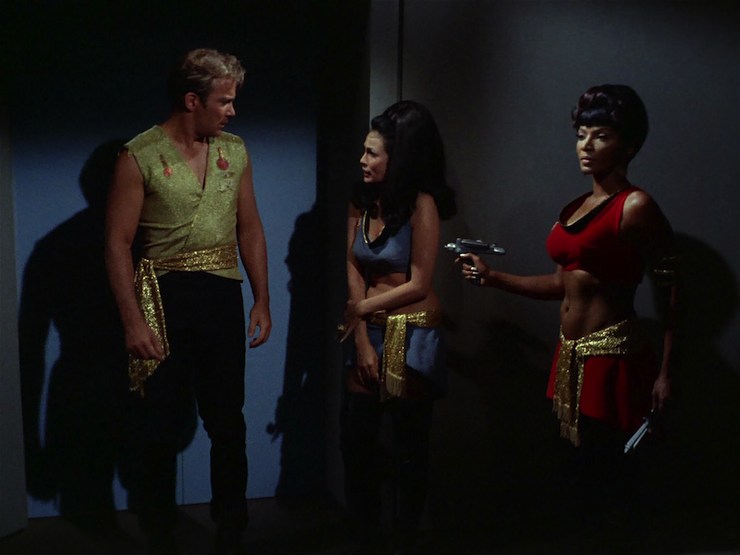
The power cuts out, but that turned out to be a delaying tactic on Spock’s part. He woke up and mind-melded with McCoy, so he knows everything now. He wants his captain back, so he’ll operate the transporter. They only have a couple of minutes, but Kirk takes that time to plead with Spock. The empire will inevitably be overthrown, which Spock says will happen in two and a half centuries. So why support an empire that’s doomed to failure? Kirk encourages Spock to change that prediction, to bring about a better galaxy.
Spock says he’ll consider it, particularly after Kirk tells him about the Tantalus Field.
The exchange works, and the landing party finally makes it home. Spock explains that he saw through their counterparts far more quickly because it was easier for the U.S.S. Enterprise crew, as civilized folk, to pretend to be barbarians than it was for the I.S.S. Enterprise crew, as barbarians, to pretend to be civilized.
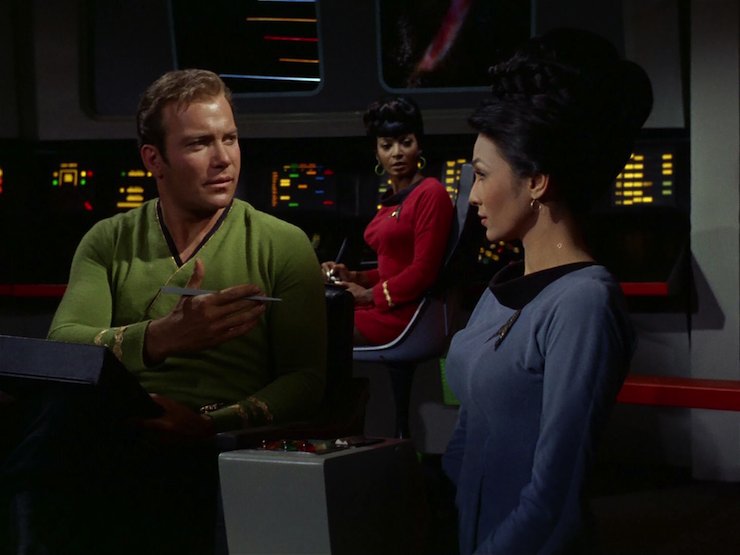
Kirk also meets the mainline version of Moreau, and it’s only a little awkward and creepy.
Can’t we just reverse the polarity? Apparently, ion storm + transporter = universe switching because science! And to avoid any further attempts to explain things, everything’s kept theoretical, and when we get to the part where the computer says it knows how to re-create the exchange, it’s put on a tape and Scotty reads it off-camera—we know Jerome Bixby doesn’t have a good scientific explanation for what happened, so he contrives to keep himself from having to come up with a bad one.
Fascinating. The alternate Spock is basically exactly the same as the mainline one—a bit nastier, and he views profit as a virtue, but not overwhelmingly different. Well, except for the beard, anyhow…
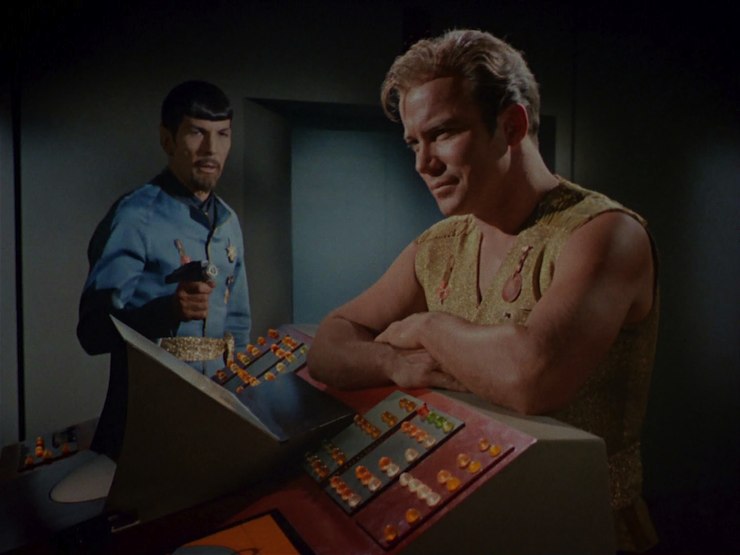
I’m a doctor not an escalator. When Scotty recruits him to help with his rerouting of the warp power to the transporter, McCoy says, “I’m a doctor, not an engineer.” Scotty’s rejoinder: “Now you’re an engineer.”
Ahead warp one, aye. The alternate Sulu is also security chief, has what looks like a dueling scar, and is pretty good at his job. He only loses in the end because of the Tantalus Field.
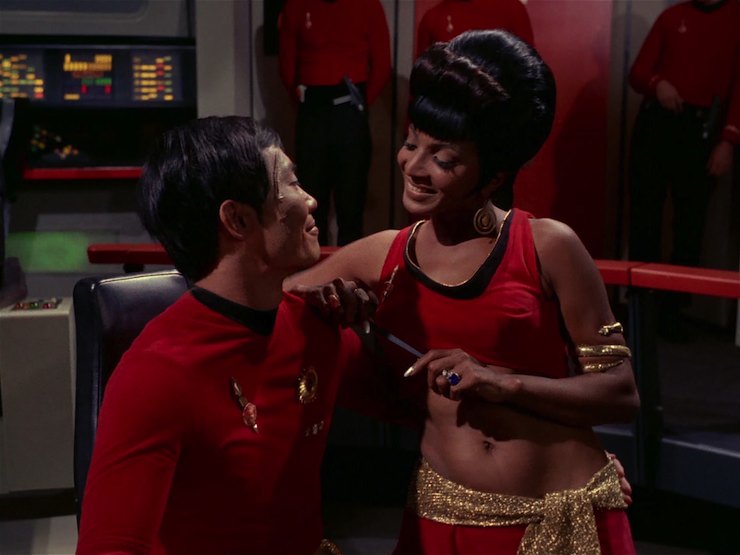
Hailing frequencies open. At first, Uhura is all afraid and scared and confused because she’s just a girrrrrrl, but later she plays Sulu like a two-dollar banjo and disarms Moreau quickly and efficiently.
I cannot change the laws of physics! Scotty works a miracle to get the transporter to do what needs to be done, because he’s just that awesome.
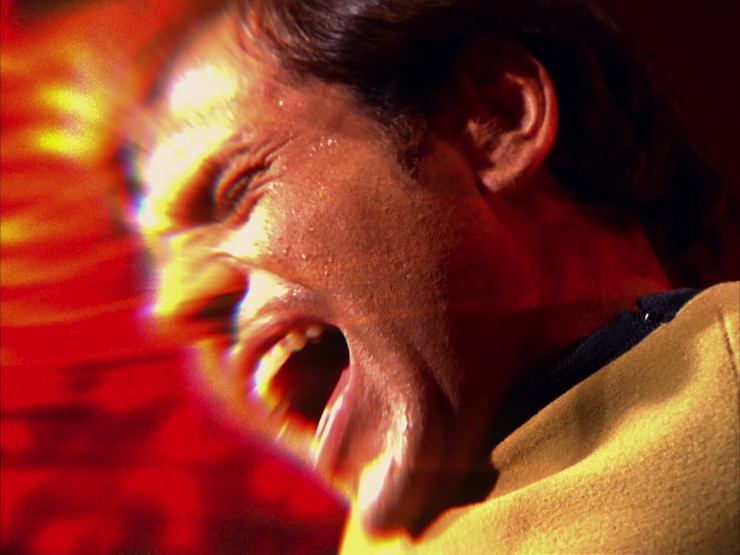
It’s a Russian invention. The alternate Chekov gets ballsy and tries to assassinate Kirk after he doesn’t follow proper procedure. It’s the action of a dumb kid getting ahead of himself and he pays for it by being put in the agony booth.
Go put on a red shirt. Most of the noncoms on the I.S.S. Enterprise serve as henchmen for the officers, though two of Chekov’s henchmen are killed by a third. Sulu, of course, has the whole security detail at his disposal, but four of his dudes are wiped by the Tantalus Field.
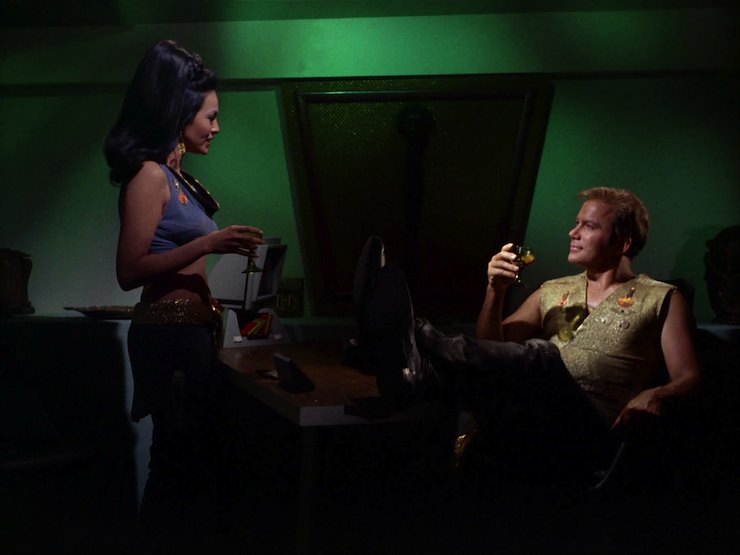
No sex, please, we’re Starfleet. Women in the MU’s Starfleet often advance, or at least improve their position, by attaching themselves to men. Moreau is the most obvious example, but when she thinks Kirk has rejected her, she mentions a commander who’s interested in taking her on. Sulu obviously wants Uhura to be his woman, but she doesn’t seem to be interested.
Channel open. “May I point out that I had an opportunity to observe your counterparts here quite closely. They were brutal, savage, unprincipled, uncivilized, treacherous—in every way, splendid examples of homo sapiens, the very flower of humanity. I found them quite refreshing.”
“I’m not sure, but I think we’ve been insulted.”
“I’m sure.”
Spock insulting humanity, Kirk wondering if he should take offense, and McCoy confirming it.
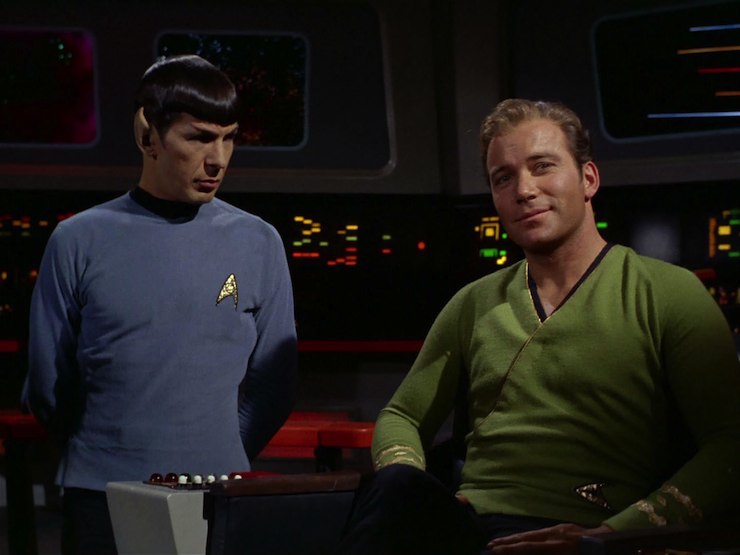
Welcome aboard. Vic Perrin, having previously done the voices of the Metron in “Arena” and Nomad in “The Changeling,” steps in front of the camera this time, playing both iterations of Tharn. Barbara Luna plays both versions of Moreau, Garth Pillsbury and Pete Kellett play hench-thugs on the I.S.S. Enterprise, and recurring regulars James Doohan, George Takei, Nichelle Nichols, Walter Koenig, and John Winston all do double duty as both versions of their characters.
Trivial matters: This is the first of four scripts by Jerome Bixby, who loosely based it on his 1953 short story “One Way Street,” which appeared in Amazing Stories.
This episode was nominated for a Hugo Award for Best Dramatic Presentation in 1968. It lost to “The City on the Edge of Forever.” It was Bixby’s second straight year with a Hugo nomination in that category: he was nominated the year before for the movie Fantastic Voyage, for which he wrote the story. (He also lost that one to a Trek episode, “The Menagerie.”)
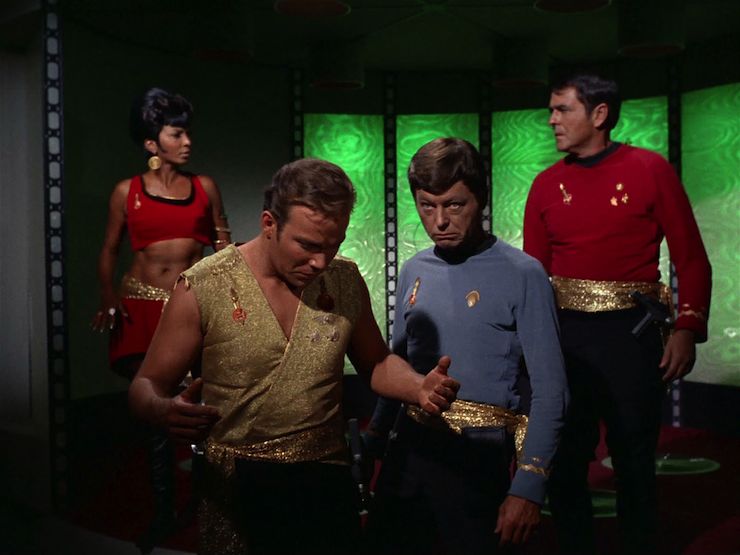
We are introduced here to the Mirror Universe. On screen, we saw the MU again on the DS9 episodes “Crossover,” “Through the Looking Glass,” “Shattered Mirror,” “Resurrection,” and “The Emperor’s New Cloak,” which served as sequels to “Mirror, Mirror,” and on the Enterprise two-parter “In a Mirror, Darkly,” which served as a prequel.
In addition, the MU has been seen in tons of tie-in fiction. In particular, DC, Marvel, and IDW all did direct tie-ins to this episode in comic book form. DC’s was in the “New Frontiers” storyline in issues #9-16 of their first monthly series, by Mike W. Barr, Tom Sutton, & Ricardo Villagran (later collected in the trade paperback The Mirror Universe Saga), which revisits the MU in the movie era. Marvel did a one-shot called Star Trek: Mirror Mirror by Tom DeFalco, Mark Bagley, & Larry Mahlstedt, which picked up on the I.S.S. Enterprise right after this episode’s conclusion. IDW’s Mirror Images miniseries was a prequel, showing how Kirk took command of the I.S.S. Enterprise.
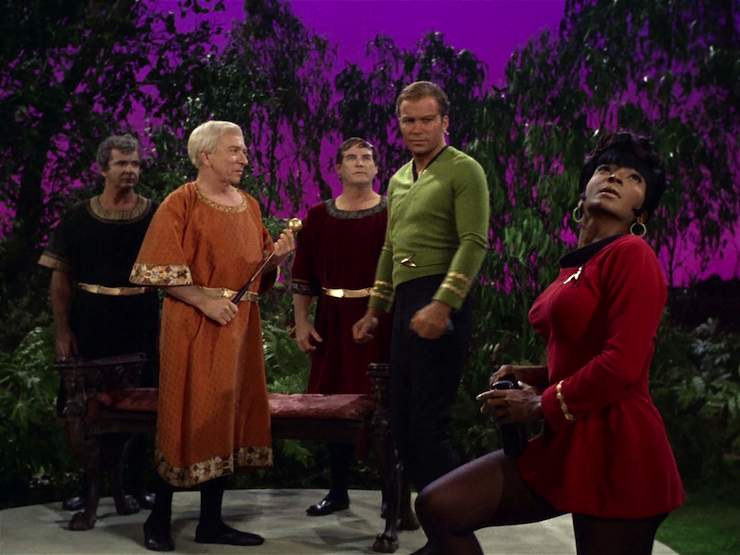
In addition, several novels have picked up the MU, among them Diane Duane’s Dark Mirror, Susan Wright’s Dark Passions, David Mack’s The Sorrows of Empire and Rise Like Lions, the “Shatnerverse” novels by William Shatner with Judith & Garfield Reeves-Stevens, as well as short novels and short stories in the anthologies Glass Empires, Obsidian Alliances, and Shards and Shadows. (Your humble rewatcher made two contributions, the Voyager short novel The Mirror-Scaled Serpent in Obsidian Alliances and the short story “Family Matters” in Shards and Shadows.) Novels in the post-finale DS9 and Stargazer series have also visited the MU.
Spock having a Vandyke beard would take root in popular culture as a method of showing that someone is really their evil counterpart.

The computer reports that Kirk took command of the I.S.S. Enterprise after assassinating Christopher Pike, who was established as Kirk’s immediate predecessor in charge of the U.S.S. Enterprise in the mainline timeline in “The Menagerie.”
The final scene with Kirk and Moreau was used as the basis for the final 23rd-century scene in DS9‘s “Trials and Tribble-ations,” showing Sisko getting Kirk’s autograph, using greenscreen technology to put Sisko in Moreau’s place.
The alternate Sulu wears red, as he’s also security chief, which means that George Takei is the first speaking character to wear all three uniform colors—he wore blue in “Where No Man Has Gone Before,” and gold the rest of the time.
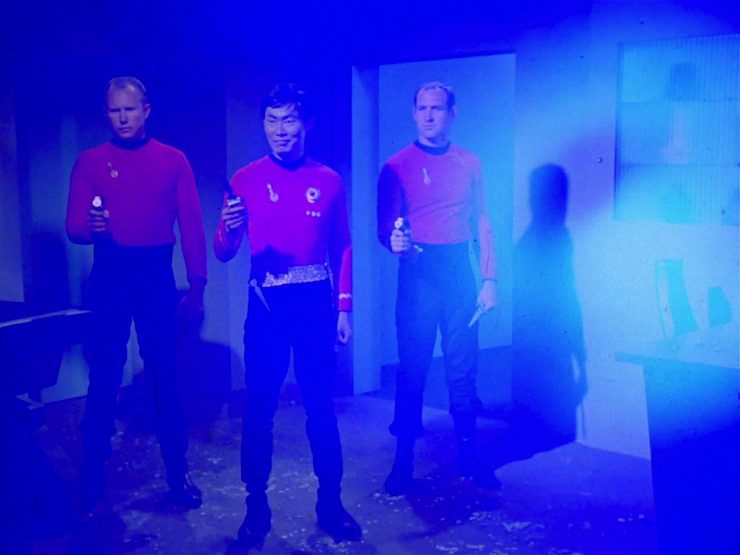
McCoy mentions spilling acid “a year ago” in sickbay, which your humble rewatcher dramatized in The Brave and the Bold Book 1.
To boldly go. “Captain Kirk, I shall consider it.” The iconic evil-counterpart episode, the gold standard to which they’re all held, and even though it’s been beaten to death and overdone everywhere in the science fiction landscape from a serious treatment in Doctor Who to a humorous one in the short-lived comedy SF show Quark to the seemingly endless returns to the MU on DS9, this episode still remains compelling viewing.
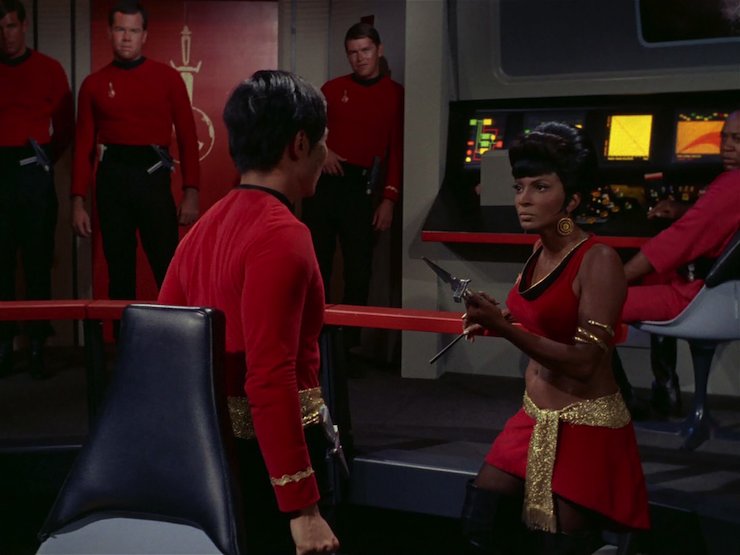
The episode is a perfect storm of good acting, good writing, and good directing. Marc Daniels does expert work, aided by some superb costuming and set design work, in creating an Enterprise that is at once exactly the same yet completely different. The constant motif of the empire logo is particularly effective, as is something as simple as a raised back on the command chair to show how much more of a hedonist Kirk is.
Most everyone plays their part well, from Shatner’s bellowing of “Let me go!” and his smarmy attempts to bribe Spock on the U.S.S. Enterprise, while his performance on the I.S.S. Enterprise while pretending to be his counterpart is nuanced and impressive. Nichelle Nichols is much more effective when Uhura’s allowed to be a strong character instead of a whimpering damsel—she’s the latter for the episode’s first half, but once she reports to the bridge, she starts actually acting like a professional. George Takei makes his Sulu magnificently evil (the scar is kinda redundant), which is more than can be said for Walter Koenig, whose gloating over Kirk before he fails to assassinate him is mostly just sad. On the other hand, nobody does a scream of agony better than Walter Koenig, and it gets quite a workout in the agony booth scene…

But the most interesting performance is Leonard Nimoy’s because, even though Kirk plays it for laughs at the end, bearded Spock really isn’t that different from our Spock, and it’s kind of scary. Then again, for all that he’s a sex symbol and the most popular character in the franchise, Spock is also, for the most part, kind of a jerk. He’s condescending, he’s sarcastic, he’s dismissive, he’s sexist—it doesn’t require much change for him to be a good fit for the MU, when you get right down to it…
Warp factor rating: 10
Next week: “The Deadly Years”
Keith R.A. DeCandido had an up-and-down 2015, but it ended well, and is looking forward to a most excellent 2016. Happy new year, everyone!










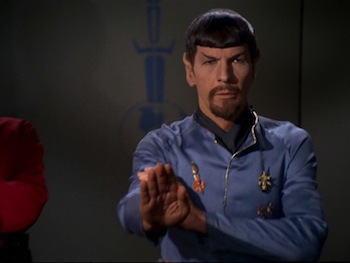
I love this episode, but it has one big hole.
Much like I can never believe the Klingons are an advanced space-faring race, I can’t believe that the Empire would actually work, even in the short term. Promotion by assassination? Would work every now and then, but you need technical experts and leadership to get the job done. You’re basically one successful Chekov event away from disaster. Empires and starships, no matter how screwed up, don’t work that way.
This is fun and iconic and all, but there’s a lot about it that makes no sense. How can the history be so different while the same people are born and end up in the same jobs on a ship with the same technology design? (Although “In a Mirror, Darkly” explains the latter, if you assume the Empire just copied the Defiant for a hundred years without having the scientific knowhow to advance on it, because they probably killed most of their innovative thinkers). Why do the landing parties switch uniforms? Was it actually just their minds that were transposed rather than their bodies? What the hell is “field density between universes?” A field of what, exactly?
And then there’s the total deus ex machina of the Tantalus Field. What does a magic make-everything-disappear weapon really add to the story? Was it that essential? It feels like a gratuitous bit of weirdness tossed into the episode for the hell of it. And why did Marlena spare Sulu after wiping out the other four? (This is, I believe, the only Mirror Universe episode in the franchise in which no regular or recurring character’s counterpart is killed.)
Jerome Bixby’s original proposal wasn’t about an evil-twin universe, just a parallel universe where history and technology had developed differently. The Federation was losing a war to a formerly nonhostile race called the Tharn (which would’ve been yet another alien race with an “Oriental quality”), and it turned out to be because phasers hadn’t been invented yet, so Kirk saved the day by inventing them. Also, he was married in this universe, and the counterpart of his old Academy rival Sam Loder was a traitor working for the Tharn. Spock was “more forceful and savage” and “closer to Vulcanian” (huh?), and Uhura was a lieutenant commander. And Kirk kept having dizzy/fainting spells because the universe was trying to reject him like an infection. While it needed work, I think it would’ve made more sense and been more nuanced than the somewhat cartoony evil-opposite universe we got. The idea for a “pirate Enterprise” seems to have been borrowed in broad strokes from Harlan Ellison’s early drafts of “The City on the Edge of Forever,” where we got to see how the ship and crew were changed by the alterations to history.
Worth noting that Fred Steiner’s musical theme for the Empire is the same theme he used for the Romulans in “Balance of Terror,” here developed more fully (and given a romantic variant in Marlena’s theme). George Duning would later borrow the same motif for Henoch in “Return to Tomorrow,” probably by analogy with Mirror Spock, so that makes it the only musical theme in TOS to be used for three different villainous entities in original scores (not counting reuse of stock cues).
@1 Chekov’s plot would have put Spock in command which wouldn’t have been a disaster. It’s not quite so idiotic when an assassination moves people up the line rather than letting the assassin cut to the head of the line. If someone’s only good at assassination, their subordinate will probably frag him to make their jobs easier.
It’d still prioritize skill at assassination over more relevant skills to command, but empires have survived with worse perverse incentives.
I never noticed that Mirror Spock had a Vulcan bodyguard! I always assumed that the highly unlikely swapping of the landing parties between universes could only happen because the ships were so similar, including identical crews, and that was why Moreau made an appearance in the final scene. There goes my theory!
Anyway, great episode, and one of Uhura’s finest hours.
@1/Ragnarredbeard: We don’t know the specifics – maybe promotion by assassination is only allowed for command officers, and it is assumed that assassinating someone successfully shows leadership potential. Or the assassinated’s superior still has to approve the promotion, and Chekov could be sure of approval because of Kirk’s behaviour towards the Halkans. I like it when they come up with something new, something that hasn’t been done by lots of real-life cultures on Earth already.
When I saw there was a comedy called _Quark_, I assumed the Ferengi entrepeneur had got his own show. Could work!
@2/Christopher: I’m guessing the reasoning behind the Tantalus field had to do with visual effects limitations. Suppose the original script had some sort of wall-mounted phaser turret designed to incinerate intruders. That plot device would have run into production complications, having to build the prop, produce multiple animated effects, plus forcing stuntmen into a prolonged shootout scene, not to mention their deaths would have been a little bit too violent and realistic for 1967 broadcast standards.
Of course, the only reason they added that bit was to generate some tension between Kirk and Moureau. Would the Captain’s woman feel betrayed and decide to enact revenge? That way, she gets to hold devastating power in her hands, if only for a brief moment.
@@.-@ “Government by assassination” actually does have a real-world historical counterpart: Imperial Japan in the 1930’s. Radical junior Army officers frequently assassinated their superiors, as well as civilian government officials, whom they felt were insufficiently aggressive toward promoting Japanese supremacy over Greater Asia, leading to the promotion of those who did forward those views.
@7/Russell H: That’s interesting. Thank you. Do you have a source for this?
@7 I don’t think Japan is a particularily good example because there were relatively few coups and assassinations in a very brief period and they didn’t have always the desired success.
A better example would be the late Roman Empire where the extended space proved to be difficult to manage for a single emperor (or two as became customary). For two centuries there were constant attempts to take power and multiple civil wars with the winners killing off the rival and his supporters. The major problem was that there was no clear procedure how to pass the power from one emperor to the next, there were elements of a hereditary monarchy, but that didn’t work out very often.
This however doesn’t include going as far down as officer ranks. I have a hard time imagining how a military system based on the principle of obeying orders is going to mix with a freewheeling anarchy where everyone can assassinate everybody. Granted there would be some power networks and there would be no constant killing, but if you can be assassinated every minute in open daylight, it seems rather difficult to focus on your job.
So I’d say that this might work for the top level, but if it goes down to lower power levels it should prove crippling to the whole system earlier or later.
@6/Eduardo: It’s not the functioning of the Tantalus Field I have a problem with, it’s the concept of it. Giving a character in a story a magic wand that makes them unbeatable is generally never a good idea. It can sometimes work if the omnipotence is itself the source of the story’s conflict, e.g. the story and Twilight Zone episode “It’s a Good Life,” but if giving the character the means to wish away any problem in the blink of an eye is just a sidebar in a story about something else, then that’s kind of a copout, a lazy way to get the character — and the writer — out of having to think of a more creative solution.
And yes, there was sometimes a tendency in later Trek and other period genre shows to toss in arbitrarily advanced, magical powers for no reason. We’ll see this a lot once Fred Freiberger takes over in season 3, in cases like Lokai and Bele’s random assortment of superpowers and immortality and Flint’s random ability to shrink a starship and freeze it in time. Freiberger would continue that habit in Space: 1999‘s second season, where the aliens-of-the-week were frequently given arbitrary nigh-godlike abilities pulled out of a grab bag (with teleportation being a particular favorite).
Folks, keep in mind what Chekov said: “no one will question the assassination of a captain who disobeyed prime orders of the empire.” Which means that there is an inquiry of some kind when you try to get promoted by assassination, so it needs to be under the right circumstances. For that matter, Sulu’s plan at the end was predicated on his staging the scene to look like Spock was carrying out his orders to kill Kirk (again, due to Kirk violating procedure) and they killed each other. Plus everyone has bodyguards and such, so officers are protected. The way it’s portrayed, assassination promotions only happen under particular circumstances, which arose entirely because Kirk has been replaced.
—Keith R.A. DeCandido
It’s the only episode where Scotty calls Kirk “Jim.”
For me it’s one of two best episodes of the entire show (the other being The City On the Edge of Forever). I’ll be rewatching it tomorrow and I haven’t seen it in about 2 years, but from memory it’s just well done all around.Slightly creepy, good plot, good acting.
I liked ISS Enterprise set, it’s not overdone and it’s still a military vessel but with enough changes to make it foreign. And uniforms in Empire are pretty though Kirk’s is a bit, khm, ridiculous…
But mostly I find this episode so fascinating because not only Spock is basically himself here, but others are not so different either. Kirk may be appaled and horrified by what he sees (Shatner got this one spot on, there are moments when Kirk looks like someone who can’t wake up from a nightmare), but he fits in this universe frighteningly well. Uhura doesn’t even raise suscpicions. And Sulu is still Sulu. None of them are out of character, just some traits are missing and some are more pronounced, and we get this twisted mirror version. It’s not hard to believe that Kirk or Spock could have turned out like that – that’s what makes it all kind of scary.
Btw, I always regretted we haven’t got to see mirror!McCoy, judging by his Sickbay that would have been interesting.
@2/ChristopherLBennett funny thing is I had no problem believing in Tantalus field, mechanics of the switch, similarities in the universe and other things you mention that are happening just because reasons, and the only thing that bothered me about this plot was how quickly mirror!Kirk got caught in our Universe. Kirk is known for his ability to adapt, this one comes from much more paranoid culture where quick thinking means survival, and he doesn’t last 10 minutes and the only explanation we get is Spock’s rather lame “it’s hard for barbarian to pass for civilized man”. Ok, I get it they didn’t have time to show what’s going on on normal Enterprise and it would have overloaded the plot, but I always want to find in-verse explanation.
Anyway, that was a great episode, love it.
@8/JanaJansen – I don’t know about “frequent assassinations” as @7/Russell H alluded to, but there were a number of coup attempts in the 1930s in Japan, some of which involved assassinations. The military wanted to seize control of the government, and tried very hard to do so.
There was an assassination attempt on the PM in late 1930, which led to the March Incident in 1931 (an attempted coup, but through rioting), which led to the October Incident later that year, (aborted coup, but would have involved several assassinations). This led to the League of Blood Incident in March 1932, which would have killed 20 politicians and businessmen, but they only managed two. So that led to the May 15 Incident, wherein some 20-year-old military officers and cadets successfully assassinated the PM (who was not the same guy as before).
So militarism was pretty strong by this point, obviously – but we still had the February 26 Incident in 1936, where more young officers assassinated their political rivals in government. All this is pretty well linked up at the government by assassination Wikipedia article.
If I had to choose only five episodes of the original series to preserve for all eternity, this would be one of them.
That’s all I have to say. :-)
The last time I watched this it finally dawned on me that the Empire in the Mirror Universe was very much like Boskone (the bad guys) in Doc Smith’s Lensman stories. In which Doc used gangsters as his model. Especially Chicago mobs where Capone killed people all the way to the top. So it was a gangster empire.
Joseph McGuire
@13/Darr: The landing party only fits in because they play-act and maintain a low profile. Even that doesn’t work, since they’re not willing to destroy the Halkans, let Chekov get tortured, or let Spock die from a head injury. The reason why Uhura doesn’t raise suspicion is that she doesn’t have any decisions like that to make. They were lucky that they had the opportunity to return within a few hours. They never would have lasted for another day.
As for the Mirror landing party, I find it plausible that they were exposed quickly exactly because they come from a paranoid culture. Getting thrown into a different universe is a highly unlikely event. “Our” landing party comes to the right conclusion because it’s the only explanation. Mirror Kirk, on the other hand, has a more likely explanation available, namely some strange coup by his not-so-loyal first officer. But I agree that Spock’s explanation is lame.
@14/MeredithP: Thanks for the link! I guess I should go read some Japanese history.
They like the name “Tantalus”, don’t they? First the Tantalus colony in “Dagger of the Mind”, now the Tantalus field.
Alan Morse came up with the name after a particularly wild party, where he remarked to his brother, Neal, “It’s almost as if we were in an alternate universe, like that one episode of Star Trek where Spock had a beard [“Mirror, Mirror“]. Wouldn’t that be a cool name for a band? Spock’s Beard.” Then, when it came time to choose a name for the band, Alan made a list of over 100 names and threw Spock’s Beard on the end as a joke, and the band chose it.
Mirror, Mirror was perfectly timed. This episode wouldn’t have worked nearly as well had they made this during the first season. At that point, the characters weren’t established enough that the differences between them and their mirror counterparts would stand out. Bixby was without a doubt one of the better choices from the available writers’ pool. Far more adept at sci-fi than Bloch, that’s for sure.
It’s the characterization and the little details that really sell the premise. If it were for the plot mechanics, this wouldn’t work at all. As others pointed out, when you think about it, the Terran Empire really wouldn’t work as an organization. The reason the Empire works on Star Wars is because there’s a central figure in power, which is the Emperor, and everyone’s afraid of the Emperor, therefore nobody dares to double-cross him nor Vader. In the Mirror Universe, we never get to see who’s the dictator that rules the Terran Empire. We only know that Kirk is a distinguished captain/mass murderer, and that Spock would somehow lead a Edith Keeler-inspired pacifist movement that would weaken the Empire, allowing for it to be preyed upon by the Cardassians and Klingons. I do like it that Enterprise established that Mirror Zefram Cochrane was still a pivotal figure in the whole process.
My only regret with this episode is we never really get to explore Mirror McCoy, Mirror Scotty or Mirror Uhura (would Mirror Scotty also be in love with his booze?). I assume they would have been explored further in another Mirror Universe story, had the show lasted longer than 3 seasons. Then again, I can’t help but wonder whether Bixby tried to sell another Mirror story but got rejected by Freiberger. It’s obvious Bixby was avaIable, after all he still got to write at least one season 3 installment.
@19/Eduardo: Bixby did pitch a Mirror Universe sequel to The Next Generation, called “Broken Mirror,” I think, but they didn’t buy it. Interesting to wonder about what might have been.
@20/Christopher: I can see why they’d refuse the Mirror concept on TNG. At that point, Roddenberry was trying very hard to avoid retreading old ground. That, plus his relentless bid for depicting the perfect state of 24th Century mankind, ran at odds with any Mirror Universe sequel ideas.
Nevertheless, we already know what happened to Worf (and also Voyager’s Tuvok). It would have been fun to see Mirror Picard, especially Patrick’s take on the character.
Mirror Data, on the other hand, I can’t see him being too different from regular universe Lore. Of course, that would depend on him having the emotion chip. However, Data’s behavior was somewhat influenced by his peers, so I can see even regular non-emotion chip Data complying with the Terran Empire, followings their orders.
And if we take for granted Spock’s claim that the Empire had no lasting future, we could have seen it actually crumbling onscreen on TNG. DS9’s Crossover obviously picked up the story right after it crumbled.
@21/Eduardo: If Kirk got through to Mirror Spock in the next to last scene in the transporter room, the Empire should crumble earlier than that.
@21, Eduardo. I can’t help but think that Data would have been copied and thousands of Datas would have been enslaved. Sort of like what Starfleet wanted to do during “Measure of a Man,” that is until Picard talked them out of it in the court martial proceedings. Don’t know why, but I have a feeling the Empire would have not cared about the autonomy of one lone android (just look at how close the mainline more “moral” universe was close to doing the same thing) and would have copied and enslaved Data faster, perhaps when they found him on that planet instead of waiting for years to even think of doing it.
However, my interest would have been Troi. The Terran Empire doesn’t seem the sort to need a counselor. Would she have been an inquisitor, using mind invasion as a way to gain information?
@23 I think that’s what she was in Diane Duane’s Dark Mirror. She was certainly scary and dangerous and, IRRC, the main antogonist on the Mirror Enterprise-D.
ETA: Makes me wish we’d seen mirror-Lwaxana.
@21/Eduardo: Apparently Bixby’s proposal was submitted in 1990 or ’91, at which time Roddenberry was no longer in any condition to make decisions about TNG. Bixby announced the rejection of the proposal in a letter to Starlog, saying “it involved members of the original crew, and Paramount wants to stay clear of that.”
Anyway, you can see mirror versions of the TNG and other characters in the various tie-ins that Keith listed in the article. Although they represent several different continuities. I think there are maybe five distinct versions of the Mirror Picard — the one in Diane Duane’s Dark Mirror, the one in Susan Wright’s Dark Passions (I think he’s in that one), the one in William Shatner and Judith & Garfield Reeves-Stevens’s MU trilogy, the one in IDW’s Mirror Images, and the one in the recent/ongoing Pocket MU continuity. But there’s apparently never been a Mirror Data in any of the versions. In the Dark Mirror universe where the Terran Empire still existed, Noonien Soong was executed for speaking out against the state, and in the ongoing Pocket continuity, Mirror Soong was stuck doing weapons research and then got, err, sidetracked by the Borg. His kind of iconoclastic inventiveness wouldn’t be nurtured in a dictatorship. There is a Mirror Universe variant briefly glimpsed in Keith’s Q & A, in which Lore is the first officer of the ISS Enterprise-E in a Terran Empire that didn’t fall.
And, no, “Crossover” was hardly “right after” the Terran Empire had crumbled. It had been gone for generations at that point, long enough for at least a generation of Terrans to grow up knowing nothing but slavery, and for Bajor to heal the scars of enslavement by the Empire and grow into a powerful and prosperous world. In the novelverse, the Empire crumbled in the 2290s, while the Mirror Images comic has it holding on as late as the 2330s (it’s mainly a “Mirror, Mirror” prequel, but inexplicably has a flashforward issue in the middle about Mirror Picard on the Stargazer). Of course, Dark Mirror was published before “Crossover” came out, so it has the Empire still around in the TNG era.
@23 & 24: In the main novelverse MU, most telepathic races (except Vulcans) have been wiped out, but the Shards and Shadows anthology established that Lwaxana and Deanna are among the few survivors, and Deanna becomes an ally of Picard in the resistance against the Alliance. Alternatively, in Dark Passions, Deanna is the consort of Regent Worf.
ChristopherLBennett @10 referenced the incredible story and Twilight Zone episode “It’s a Good Life”, but didn’t mention that it also was written by Jerome Bixby.
@26/MackTheFife: Oh, of course, how could I miss that? So maybe that’s how the Tantalus Field works — it’s actually the Tantalus Cornfield!
krad, IDW also had Mirror Universe versions of some of the New Frontier crew, in the miniseries “Turnaround”.
@@.-@ – Jana: I hadn’t noticed the Vulcan bodyguard either!
@21 – Eduardo: Roddenberry trying very hard to avoid retreading old ground? Sure, that’s why the first non-pilot episode of TNG is a remake/sequel of “The Naked Time”… If anything, showing a horrible Mirror Universe would have made the Federation look even more utopian.
@23 – Victoria Hannah: Millions of Datas, yes, you’ve got it there. And Mirror Deanna would have probably still been a counselor, but one that worked in reconditioning, brainwashing, etc.
@29 – Comment removed per Tor.com’s moderation policy. Please feel free to restate your opinion in a more civil manner.
@28/lordmagnusen: I like the idea that they would call someone who does brainwashing a counselor. That’s like “Ministry of Love”.
This is also one of my favorites from the original series. Moreau was a great character. She wasn’t THE captain’s woman, she was A captain’s woman. She’d make her own captain if she had to. She makes Lady Macbeth look like an amateur. If I remember correctly, Lady Macbeth’s husband got a promotion by means of assassination. In Europe there was a period where an assassination might mean a promotion given the loose laws of succession and the “you and what army” approach to things.
The closest thing to Mirror, Mirror in TNG is Yesterday’s Enterprise which is one of my favorite TNG episodes. The writers used a time warp and alternate time line to explore a Federation where the Enterprise a war ship fighting a long hard war, and Picard is a military commander constantly forced to make hard decisions despite his better nature.
This episode is missing from the index page; “Newest Post” is still “The Apple”.
Also, the episode title is once again a literary quotation. But probably everybody knows that anyway.
With the advent of drone warfare, I think the Tantalus Field is a more timely and realistic plot device than ever.
Whatever logic and science problems this episode has, it’s a classic. Absolutely one of the top five, as Glenn/@15 said above. Duane’s Dark Mirror is one of my favorite Trek novels, too.
And this is one of my favorite references of the episode in pop culture:
Goes on my banister garland with pride every holiday season.
@33 – Thanks for letting us know – the post should be in the index now.
@28: Not exactly. That was the exception. An episode deliberately designed to pay homage to the original material and still put some distance between TNG and TOS, which is why the plot speficies that McCoy’s vaccine doesn’t work on TNG’s version of the virus.
For those who wanted to see more of Mirror Kirk, Uhura, Scott, and McCoy: The fan produced series “Star Trek Continues” (a completely separate group from Star Trek Phase II) made a sequel to “Mirror, Mirror” called “Fairest of Them All” which takes place entirely in the MU immediately after the regular crew beams back. This episode takes Mirror Spock in a completely different direction than the novel “The Sorrows of Empire”. As a special treat, Scott is played by Chris Doohan, and he is so much like his father that it’s almost scary.
The Tantalus Field is not a source of conflict but the resolution to the episode when our Kirk offers it to mirror Spock. Which the implications of Kirk recommending that the other Spock pursue a ruthless program of political assassinations in order to get in the inner circle of imperial power to effect change is, uh, interesting.even if Spock is the closest thing to a decent person on ISS Enterprise.
Mirror Moreau giving a relationship ultimatum to Kirk seems like a big risk for her considering she knows about the Tantalus Field and how to use it. Would mirror Kirk let her go with that knowledge without disappearing her? She seems more savvy than to do that even if the writers thought they needed to indicate tension in that relationship.
And with our universe’s Moreau: what is the protocol for flirting with the doppelganger of someone you made out with?
@38/Crusader75: I don’t think that Moreau gives Kirk an ultimatum, I think she assumes that he has left her when he wants to go instead of staying with her.
I liked both Mirror, Mirror and In a Mirror, Darkly. It both worlds it was a better way to get things done.
The episode sets up a nice moral quandary. Pacifism, Pragmatism and the Empire’s do what we want or we kill all of you. The aliens remarkably would rather let their entire race die than comply. Kirk stalls the massacre but then fails the whole test. He flips back and lets evil Kirk go back. His comments to Spock at the end are not enough. He should have blown up the Enterprise or taken it over and attacked the Empire. It may be another Universe but he chose to save himself and doomed millions.
@41/tipsy: I don’t think he could have taken over the Enterprise and attacked the Empire. He didn’t know enough about the inner workings of the Empire. In the short time they spent in that universe, he would already have been killed twice if he hadn’t been lucky.
Blowing up the Enterprise might have worked, but then the Empire would send another ship to destroy the Halkans, so it would merely have been more stalling.
Star Trek Continues’ “Fairest of them All” is a great sequel to this episode, giving us a view of what happens immediately after Mirror Kirk and his crew return to the I.S.S. Enterprise.
Love this episode. Even after all the times I’ve seen it I watch in rapt attention every time. I always found Mirror Spock totally different from our Spock, similar at their core, but still very different. Mirror Sulu is definitely different, and George Takei probably enjoyed getting to play almost a different character. And Uhura gets to shine here, as she always does when she’s not tied to that damn communications console. A fun hour.
@41/tipsy: It’s not Kirk’s job to force his morality on others. That’s what the Prime Directive is all about. People need to solve their own problems in their own way. Surely the history of American interventionism has proven time and again that trying to force a “better” solution on another culture just leads to new and worse problems in the long term. If the people of the society don’t embrace change for their own reasons, then trying to force that change on them will just make them resent and resist it. That was clear enough to the writers of TOS fifty years ago, which is why they created the Prime Directive in the first place. Yet we’ve continued to make the same mistake over and over, with equally disastrous consequences, and some people still haven’t figured it out today.
Violence doesn’t fix things. Improvement can’t be forcibly imposed by outsiders; it has to come from within, through reform and hard work. It’s a slower, more gradual process, not as satisfying to those who want easy answers and instant gratification, but it’s the only way it can work. And the fact that Star Trek understood that was what makes it superior to so many other sci-fi franchises that would’ve just pretended the problem could be solved with a big explosion. (Heck, even Star Wars, the archetype of “let’s blow this thing and go home” solutions, doesn’t really make that claim — because each time they blow up the Empire’s superweapon, the Empire or its successors just come back later and do more harm.)
@44 Great response. Kirk calls this out at the beginning when he points out that the Federation could seize the D crystals but won’t. I agree with you on American interventionism and as a policy you are right (and as @41 points out, my plan would probably fail. ) But as an individual what is your responsibility? This is the reason this is my favorite episode.
@45/tipsy: I like Kirk’s answer: As an individual, your responsibility is to inspire others to become better.
In the “Autobiography of James T. Kirk” (David Goodman), “Kirk” makes the assertion that he was able to pass as the Evil Kirk in the Spocksbeardverse partly because he had a similar experience before (The Enemy Within) and could draw on his own dark half. Kirk as method actor; who knew?
@47/sardinicus: I’d say he only passes as the evil Kirk because nobody gets the idea that he could be anyone else. He doesn’t behave like his “dark half” at all.
@48/Janajansen: Well, Shatner acting as Kirk acting as Evil Kirk might have been a bit too Inception for the skill set.
In the book it’s one of the interesting bits as Goodman tries to tie together some larger arcs from the independent stories.
I probably don’t get your joke…? But I think if Kirk actually tried to act like his evil counterpart, it would ruin the episode. I like it that he refuses to do a lot of things he would have to do to maintain a perfect cover, like destroying the Halkans or allowing Chekov’s torture to continue.
HEY! Uhura has every reason to be creeped out as hell and reluctant to go to the bridge alone. Would it be out of place for a male crewman to express nervous reluctance? No it would not. Note that McCoy and Scotty get to stick together.
KRAD: “McCoy is appalled at sickbay, as everything is all rearranged and messed up—but the spot on the table where he spilled acid has the exact same acid stain on it.”
McCoy: “What is this? Everything’s all messed up and changed around, out of place… No, not everything. That spot. I spilled acid there a year ago. Jim, what in blazes?”
I’d always assumed McCoy was surprised to find there was no acid spill on his mirror universe counterpart’s table. His very words seem to suggest that. If there was an acid spill on the table, why would he say “I spilled acid there a year ago” instead of something like “that acid stain’s the same as in my sickbay.”? Probably because the script told him too, but it’s an odd phrasing if he’s pointing out that Mirror McCoy’s acid spill is identical to his own.
I decided to check the DVD to see what we actually see on the table. No help there; there are yellow and blue stains near the edge of the table, but McCoy seems to be pointing toward the center. It’s not quite clear what he’s pointing at. There’s stuff scattered about the table, but it’s unclear what it its.
The Blish adaptation doesn’t even have that scene, so no help there, either.
So, do we know that there’s an identical acid stain in both universes or is that just supposition? Even the phrase “no, not everything” doesn’t help. It could either mean the acid stain is the one consistent element McCoy recognizes in the disordered mirror sickbay or it could mean he considers his own acid spill out of place and that there is no out-of-place stain in the mirror sickbay.
It still seems to be that McCoy is pointing out the lack of that particular acid spill, whatever else the condition of the mirror sickbay, but maybe I’ve misread the scene all these years. Does anyone else share the same interpretation of that scene?
@52/Rick Keating: I disagree — the phrase “No, not everything” (is changed) can only mean that the acid spill is one thing that isn’t changed. He’d have no reason to say it otherwise. How could he consider his own acid spill “out of place?” That makes no sense in the context of the line, in which he’s specifically talking about the ways this sickbay differs from his own. So you’re overthinking it. He’s saying everything is changed around except that stain, which is the same. In the same way that the ship as a whole is a mix of things that are wildly different (the Terran Empire, agonizers, captains’ women, goatees) and things that are inexplicably the same (the crew, the design of the ship, the mission to Halka).
I probably am over thinking it, but McCoy’s “I spilled acid there a year ago” phrase is odd if he’s pointing out something that’s the same in both universes. Consider if a group of people return to their home to find it subtly altered. If one character says “I painted this living room a year ago”, wouldn’t that imply that they’re in a version of the living room that wasn’t painted? I know I would have used that sort of phrasing if I’d wanted to convey that sort of impression, while a phrase like “The furniture’s all wrong and the window faces the side yard, but the walls are the same shade of blue” would indicate that both incarnations of the living room were painted, regardless of other differences between the two versions of the house.
It may also be that even though I saw “Mirror, Mirror” in occasional reruns in the 80s, I tape recorded it in the 70s, so maybe my interpretation of the scene has been based on McCoy’s words rather than what’s visible on the table.
@54/Rick Keating: “I probably am over thinking it, but McCoy’s “I spilled acid there a year ago” phrase is odd if he’s pointing out something that’s the same in both universes.”
But the line does not exist in isolation. It comes right after “Everything’s… changed… No, not everything.” In context, the explicit purpose of that sentence is to explain the previous line “not everything,” to specify what is not changed from his own sickbay.
“In context, the explicit purpose of that sentence is to explain the previous line “not everything,” to specify what is not changed from his own sickbay.”
Been busy; haven’t had a chance to respond till now.
I get what you’re saying, and you’re probably right, but McCoy’s line, “That spot. I spilled acid there a year ago” ironically implies there’s no acid stain in Mirror McCoy’s sickbay. It’s an odd way to phrase it if you’re saying it’s the same in both universes. It would have been better if he’d said something like, “That spot. It has the same acid stain I made a year ago.”
No doubt there’s another universe out there in which a version of “Mirror, Mirror” aired where McCoy did say that.
@56/Rick: You keep taking that line out of context, and you can’t do that, because its meaning comes from the lines immediately preceding it. “Everything’s changed. No, not everything. That spot.” Obviously, that is meant to say that the spot is the one thing that isn’t changed. You can’t just chop off the first part of the statement and pretend it has no bearing on the meaning. Context matters.
Christopher, No, I’m saying it’s a poorly phrased sentence, even taking context into account. Jerome Bixby no doubt intended the scene to indicate that McCoy’s pointing out an acid stain they can all see. That being the case, why write dialogue specifying that he spilled acid, instead of saying the stain is identical?
Again, I accept your point that McCoy’s indicating a commonality between his counterpart’s sickbay and his own, that my initial understanding of the scene was a misinterpretation; I’m saying the wording could have been better.
Let me put it to you this way: If “Mirror, Mirror” had never existed as a TV episode and you were writing it as a novel, would you have McCoy say “I spilled acid there a year ago” or something like ” That acid stain. It’s the same as in my sickbay.”? I’d have chosen the latter.
@58/Rick: Again, the line is perfectly clear when considered in context with what came before. I don’t have a problem with how McCoy phrased it. It wouldn’t be enough say “that stain is the same” without explaining the origin of the stain, since what’s important is that it’s connected to a specific incident. It’s making the point that some events happen the same way, on both large scales like the Halka mission and small scales like an acid spill, while others are quite different.
Superb acting by Nimoy. His best scene is right after the opening credits, where he shows his contempt for Kyle by simply opening his hand and letting his agonizer fall to the floor
Mirror universe mic drop!
I sometimes wondered if Mirror Spock was fully Vulcan (in the IDW comics featuring the Mirror Universe he was still half human). Also, was the MU an alternate timeline or an alternate reality? Based on the time travel in other stories, if history had been changed at some point to create the Empire, then the original timeline ought not to have existed, correct? Or vice versa, for that matter.
Poor Chekov. Seems he’s always the one never catching a break.
I would have liked to have had a scene where Spock realized that he had the “wrong” crew members on the Enterprise.
@62/mspence: If Spock had a different, Vulcan mother, he’d be a different individual, full stop. He wouldn’t be the Spock we know — more a sort of half-brother.
“Also, was the MU an alternate timeline or an alternate reality? Based on the time travel in other stories, if history had been changed at some point to create the Empire, then the original timeline ought not to have existed, correct?”
The two terms are interchangeable. Fiction tends to use numerous different labels for the exact same physical phenomenon — alternate timeline, parallel universe, alternate reality, etc. They’re all just alternative quantum states within the universal Schroedinger equation. Sometimes they’re created by time travel and sometimes they diverge spontaneously, but otherwise the physics should be identical. (One could say that parallels instigated by time travel are merely a special case of parallels arising spontaneously. It’s doing something artificially that already happens naturally anyway, so the mechanism isn’t really different. Just because you can pull a leaf off a tree in autumn, that doesn’t make the process fundamentally different from letting the leaf fall off on its own.)
And even within Trek, alternates created by time travel don’t always “erase” the originals (and indeed they never should, despite what fiction has conditioned us to expect, because that concept is physically impossible and logically self-contradictory). In “Yesteryear,” when Spock went back to restore his own timeline, he told Thelin to live long and prosper in his, implying that he expected Thelin’s timeline to survive even after Spock “changed” things back. And of course the Kelvin Timeline coexists with the Prime timeline.
@10/CLB: Another example of this is ENT Exile. The alien magically neutralizes the Enterprise to force Hoshi to stay with him. That was an otherwise good episode , but that scene took it down a few notches for me.
@13/17: I actually have zero problem with Spock’s explanation of how he identified the barbarian versions of our heroes. It’s a similar idea to the truism, “it’s easier to destroy than to create”. Personally, I was surprised Kirk even asked the question. He saw how everyone acted in the MU first hand. I thought it would have been easy to deduce how his counterparts were discovered.
@51/Roxana: I agree, I’d be terrified too! Although I think the complaint is more about the fact that it seemed that Uhura was scared because she was a woman. The episode doesn’t go out and say that like Wolf In the Fold infamously does, but based on the pattern to date as of this episode, Star Trek overwhelmingly falls back on female clichés.
@52/53/54/55/56/ (I’m getting dizzy ) 57/58/59: I personally was not confused at all at the comment of the acid stain. I was pretty sure McCoy meant that it was the in the MU too.
) 57/58/59: I personally was not confused at all at the comment of the acid stain. I was pretty sure McCoy meant that it was the in the MU too.
@62/63: This discussion gave me a thought. In ENT A Mirror Darkly, we see Zefram Cochrane pull out a shotgun instead of extending a hand. Obviously it’s supposed to suggest this as the deviation point between the normal universe and the MU. But when you think about it, was it? Did Cochrane always have that shotgun stashed in his jacket, even in the normal universe? I think it’s an interesting question to ponder.
@64/Thierafhal: “In ENT A Mirror Darkly, we see Zefram Cochrane pull out a shotgun instead of extending a hand. Obviously it’s supposed to suggest this as the deviation point between the normal universe and the MU.”
I disagree entirely. On the contrary, it’s saying the universes were already different well before that point, since Cochrane’s history would have to have been very different in order for him to react to the same event in such a profoundly different way. And when Phlox and T’Pol discussed Earth history in Part 2, they clearly established that the Prime Earth’s history differed from their own going back centuries, even millennia (though I suspect Phlox just thinks that because the Empire rewrote its own history to fit its warped values). Plus there’s the revised main title sequence showing divergent events such as an astronaut planting an Imperial flag on the Moon instead of the American flag.
@65/CLB Well to be fair, the ST:FC scene is the teaser, that’s why I suggested it to be the point of divergence. I guess then in hindsight the teaser was more of a way to set the tone for the rest of the two-parter. The altered credit sequence further accentuates that and also tells the story of how things came to be. Not sure why I didn’t think of that.
@66/Thierafhal: I think First Contact is the point of divergence as far as the Vulcans and the rest of the universe are concerned. To all indications, the only difference between the Prime and Mirror timelines is that Earth’s history was darker, so that when humans encountered other worlds, it was as conquerors rather than explorers. The only differences in the other species were the result of the differences in humanity, in that they either had to become harsher to survive as part of the Empire or else be trampled under its boots. And Bajor’s history was different because it was conquered by the Empire decades before the Cardassians came, and since the Cardassians and Klingons were enemies of the Empire, that made them the Bajorans’ allies as well as each other’s.
So basically that teaser was saying that things were the same from the Vulcans’ perspective, but they arrived to find an extremely different humanity than their Prime counterparts did.
Really, though, I think it was just that the makers of the episode wanted to surprise us by showing a familiar event from Trek history and then giving it a darker twist. It didn’t literally mean it was the moment of divergence, it was just a “gotcha” moment to establish that we weren’t in the version of Trek’s past that we expected.
@67/CLB:
And that it did! It was a well done scene.
There’s one thing I have to scratch my head about. The Vulcans seemingly didn’t have an emergancy plan for if things went badly. Obviously In a Mirror Darkly is a comic book plot and viewers are encouraged to just enjoy the mayham. If the Vulcans weren’t overpowered, we wouldn’t have this two-parter. However, I remember even thinking back when FC was released, about how nonchalantly the Vulcans stepped out of their ship. Even if humans in the main universe aren’t savage barbarians, things still could have ended up a disaster, haha.
Just watched as part of the “Roddenberry Vault” – and I am pretty sure that I actually never saw this one before. This is remarkable because as a kid, I was glued to the reruns. I’d heard enough about it to assume I had seen it, but I think this was the first time.
In a young genre sort of way, it was great! Was it really the first (popular) use of the alternative universe trope, where we get to meet the darker/differenter/what-if versions of our favorite folk? If so, it gets even more points for being so good.
Uhura doesn’t seem too scared to me; it’s a freaking scary situation. Except there’s one shot where she has a comically horrified look, and I can only guess the editors used it because there was no other take that worked. She isn’t happy to be left alone on that scary bridge where all kinds of faux pas might reveal her, and uh huh that’s a perfectly rational response to that situation. Then she gets to kick ass later.
Moreau is cool. Interesting, layered, smart, sexual without being eyerollable, and good at the quick alliance. I’m a little disappointed that she’s a random ensign at the end; it would make more sense if she’s a scientist just like the MU one, only with different personal ambitions.
I had little problem with the Tantalus field, aside from how easy / ex machina it was. It serves three purposes: It explains how Kirk has ascended, it allows for the surprise rescue by Moreau (which confirms that our good universe has already been a good influence, and she’s on our side, which we weren’t sure of until then) , and it gives MirrorSpock a tool with which to clean up Dodge, which for all its horrifyingness, at least it’s not torturing anyone.
I wonder if they named it Tantalus because of the Greek myth. Best I can figure is, it has to do with power, corruption, deception, and the question of whether gods can see and know everything. In the end, Tantalus’ ambitions leave him eternally tortured; maybe that’s relevant.
At first I was concerned that MU Kirk had it so well installed; who were the contractors? Did he tell them it was a teevee? Then I realized, it had to be installed in quarters so it wasn’t a weapon that could be stolen too easily.
That said, it could have been cooler. It had like six buttons. In the reboot of this episode, I would give it several knobs just for remote camera control, let alone choosing your victim and such. And some security, so only someone who knows the password can use it, etc. It has too much of a bibbidi bobbidi silliness quality and that does harm the episode a little, I think.
Oh but that does remind me of its fourth purpose: It’s the witch’s mirror, mirror, which she uses to look at what Snow White is up to.
@69/jofesh: “Was it really the first (popular) use of the alternative universe trope, where we get to meet the darker/differenter/what-if versions of our favorite folk? If so, it gets even more points for being so good.”
I profoundly doubt it. If nothing else, “Mirror: Mirror” only beat Lost in Space‘s “The Anti-Matter Man” to the punch by two months, suggesting that both were inspired by a pre-existing concept (and given the vagaries of TV release dates, there’s no telling which one was written or filmed first). Andre Norton’s 1958 novel Star Gate uses a similar idea, though I’m not sure if that would meet your definition of “popular.”
“I had little problem with the Tantalus field, aside from how easy / ex machina it was.”
I recently realized that the big problem with the Tantalus field is that Starfleet already has essentially the same technology. It’s called the transporter. Seriously — it can reach through walls and disintegrate people. Just leave out the reassembly step and it’s basically the same thing. So while the visual spying aspect is significantly more sophisticated, the actual disintegration part isn’t nearly as great an advancement as portrayed, aside from presumably being undetectable. (And we don’t know if it would work through shields, since we only see it used within the ship.)
Ah, “Mirror, Mirror”, the classic episode that comes down squarely on the nurture side of the nature/nurture debate and gives the lesson “this could have been you.” It must have shattered Kirk’s ego to see what he was capable of given different circumstances, right after smugly assuring the Halkans that he would never use force to get what he wanted. But because he’s Kirk he manages to get out of this week’s situation with his morals intact.
Unfortunately the moral lesson was lost in DS9 where the endless excursions into the mirror universe were just an excuse for the actors to have fun playing EEEEEEVIL versions of their characters and have Nana Visitor dress up in kinky leather outfits (not complaining too much about the latter).
@71/MoebiusXerxes: “right after smugly assuring the Halkans that he would never use force to get what he wanted”
He didn’t talk about himself, personally. He talked about the society he represented, using “we” and “our” throughout.
“Unfortunately the moral lesson was lost in DS9”
Oh yes. This is an episode that should never have had a sequel. It had a perfect hopeful open ending, ruined by DS9 for the sake of fan service.
Now this is a delight! In my comment for “The Apple” I complained about episodes running out of steam before the conclusion; “Mirror, Mirror” more than keeps its steam going, it makes every scene amazing. It’s no wonder this one’s a fan favorite.
I have to wonder though, is it just the Empire that’s evil? The Halkans aren’t bloodthirsty warmongers in the MU and we don’t see what the Klingons and Romulans are like, so I’m assuming this is the main MU difference, not that every one good is now evil and vice-versa, but I assume that’s explored in the later visits to the MU…
@73/Fujimoto: That’s right, later episodes establish that other civilizations differ only in their response to facing a human Empire instead of a Federation. It’s not a “vice-versa” universe; indeed, the philosophical point that gets touched on is more about how similar the two histories are, how short a leap it is from the civilized person to the savage. People misinterpret the “Mirror” metaphor. “Mirror, Mirror” is a reference to the Magic Mirror in Snow White that revealed the unvarnished truth. It’s not about opposites, it’s about seeing the ugly truth about ourselves, the truth that the savage is more a part of us than we like to think.
Structurally, this episode is one of the show’s peaks. It knows it can’t possibly support dueling stories, evil Kirk and his minions up to mischief on “our” Enterprise vs. “our” Kirk and company trying to survive on the “evil” ship, so it uses tossing one of those plots by the wayside to help convey one of the remaining plot’s key points: it’s a lot easier for stable people to survive in an unstable and paranoid world than for the unstable and paranoid types to pretend to be stable.
Ultimately, this makes the hope Kirk grants the “evil” world believable to the viewer and thus satisfactory as a resolution—sequels by entirely different shows notwithstanding. “Evil” Spock has stable and constant qualities that will allow him to continue to influence the world Kirk leaves behind, even when the viewer knows he’d have to do that through conniving and deception. The advantage “our” Kirk, McCoy, Scotty and Uhura had over their enemies, and the advantage “our” Spock had over their evil counterparts, becomes the advantage “evil” Spock has over seemingly everyone else around him.
…as an addendum, the above is exactly what “The Savage Curtain” seems to forget entirely: that “good”, at least as portrayed by most of Star Trek, has its own strategic advantages, such as promoting cooperation in planning, or promoting challenges to the rules of the game rather than simply trying to play it to one’s own cutthroat success. Potential solutions abound within that episode that can’t coexist comfortably with its fistfight ending: Kirk explaining to the Excalbians that their lack of knowledge of good and evil has made their chosen contest (a motive-free murder-thon) useless as a measure of the power of “good”; the crew of the Enterprise risking their own safety in a desperate bit to intervene and rescue Kirk and Spock, demonstrating to the Excalbians that “good” ultimately can bring more power to bear, because good people choose to work together even when they don’t all have eyes on each other; and so on. Those armchair plotting solutions mimic those found in other episodes, but so does everything about “The Savage Curtain” including its chosen “solution”, and the comparison is still hardly to its benefit.
Hallmark ™ has made a wonderful wonderful set of talking/interacting Xmas ornaments
including the ship all the sounds, as collectables. I had to come back to say that because
the collection captures the episode pretty well. Its limited time and the last two McCoy and Scott,
come out this year.
One of my favorite episodes of TOS and the Star Trek franchise in general. Just a great science fiction concept, compelling, well-acted, and just plain fun. It also made great use of Uhura and I believe is Nichelle Nichols’ shining hour. Thank god Reverend King convinced her to stay on the series beyond the first season.
Above there is an image of Uhura holding a phaser at Marlena Moreau. This is the only time I can ever recall seeing Uhura with a phaser. Which led me to wonder – is everyone on the Enterprise armed with phasers while on duty? Most of the senior officers, security guards and members of landing parties carry phasers, but what about the technicians, scientists, yeomen and medical staff? I mean, is Nurse Chapel always armed? And do crewmembers carry weapons even when they’re relaxing in the rec room or enjoying shore leave? Being on a confined ship with over 400 heavily armed people would be scary.
@79/Palash: Since TOS uniforms didn’t have pockets, you can always tell whether someone is armed or not, and usually only security personnel were armed on the ship. Presumably things are different in the Mirror Universe.
Another aspect of this episode that puzzles me is that we had an interracial kiss between Kirk and Marlena Moreau (a full year before Kirk kissed Uhura in ‘Plato’s Stepchildren)! I don’t know the ethnic background of the actress who played Moreau, but she appears to be East Asian or Hispanic. Why wasn’t this considered an interracial kiss??
@81/Palash: Well, the claim about “Plato’s Stepchildren” has been thoroughly debunked anyway. There’s a good analysis of it archived here, including a mention of the issue you raised: https://web.archive.org/web/20160326100655/http://www.agonybooth.com/agonizer/TVs_First_Interracial_Kiss_Star_Trek.aspx
But basically it boils down to two things. One, white/Asian or white/Hispanic romance were never stigmatized in American culture as much as white/black romance was, so it wasn’t as big a deal. Two, Luna is multiethnic and has been cast as characters of numerous ethnicities, and Marlena was not presented as a non-white character.
@81/Palash: Barbara Luna is half-Filipino/half-ethnic Jewish (coincidentally my same racial makeup) so she can be considered partially East Asian. In fact her unique look landed her acting roles of varying ethnicities. So if you want to be completely literal, then yes, it was an interracial kiss between Kirk and Moreau. But let’s not kid ourselves, Luna could also be assumed to be Caucasian with dark features (it’s happened in my case) and if she were fully Asian, I don’t believe the kiss between the actors would have made nearly the ripples that the Kirk/Uhura kiss did. In the Cold War era it became common for American GI’s stationed abroad in East Asia to have relationships with the women there. As a response, the U.S. government passed the War Brides Act of 1945 that allowed for the assimilation of these Asian women into American society. While these women became accepted, they were still stereotyped however and made to fit into assumed gender roles. But my point is, white men and Asian women being intimate to a degree on mainstream television would not create an uproar like white men and Black women would. So the Kirk/Uhura kiss was rightfully deemed groundbreaking for its era even if Kirk had already kissed an Asian woman before that.
https://armstronghistoryjournal.wordpress.com/2017/11/16/the-representation-of-asian-war-brides-through-a-cold-war-lens/
@79 – Uhura also used a phaser in The Lorelei Signal from the animated series.
@79/Palash: Uhura also pointed a phaser at her young Starfleet companion in Star Trek III during the Enterprise heist scene. And without going back to watch it, I believe she was also armed in Star Trek VI when she beamed down with the rest of the cast to the conference on Khitomer to look for potential Federation president assassins.
Palash@79: Frankly, Uhura gets serious weapons time in ‘Mirror, Mirror’, brandishing both a dagger and a phaser (and looking pretty lethal with that dagger).
And, lest we forget, for one, brief, shining moment, Uhura does brandish a phaser in ‘The Gamesters of Triskelion’, before the landing party (‘away team’? feh!) discover that their weapons don’t work.
Good points by all regarding the so-called “inter-racial” kiss. I guess we could also say that we had an interracial kiss in the first season between Khan and Marla McGivers, but there’s no need to rehash the troublesome depiction of a Sikh by a Mexican actor again!
Uhura gave Christine Chapel a kiss on her way to reunite with her fiancé in “What Are Little Girls Made Of?”
I crawled my way to “Mirror, Mirror” in middle school after first being exposed to the MU through two of the video games.
STVOY: Elite Force has a cool section where you rescue a crewmate on a rusting Terran Constitution-class melded with Klingon, Malon and Hirogen ships in a gravity well. The Terran ship’s walls are scratched with Klingon insignias and “NO FUTURE,” cluing us into these people being runaways from the Klingon-Cardassian Alliance’s takeover since Spock’s turn towards being merciful. It’s a series of four levels that establish these people are agitated deserters and not just eeevil in goatees and go-go boots. Not much detail for a 2000 FPS, but still enough to add a small pang of regret when you shoot them. Big kudos.
Star Trek: Shattered Universe is a hard-as-nails starfighter sim that weaves DNA from the Interplay command sims. As a pilot in Captain Sulu’s Excelsior shortly after The Undiscovered Country, you and your crewmates end up transposed to the MU after a dilithium/storm vortex explosion. The only way to get home is another storm in Tholian space: a month-long trip through Klingon and Romulan territory.
It’s a game where blowing up cap ships is as fun as going back and forth in a parking space. I highly recommend Umbra Shepard’s Let’s Play for an in-depth look (even with the invincibility cheat on, this game is a chore. Looks great, though.)
As brainless as the gameplay is, Shattered Universe tried to fit in too many TOS homages that messed with its time frame. Suddenly, the big amoeba comes back to life in Romulan space, the planet killer becomes a Terran WMD on course to destroy Qu’Nos after blowing up Praxis, the Balok puppet becomes a real boy, etc. It feels too fanficky except for George Takei and Walter Koenig’s brilliant performances as best frenemies. It was chilling to hear Chekov’s logs when you failed along with this pre-mission “Russian proverb”:
Chekov has no idea of either Sulu’s machinations, which are the best part of SU‘s writing. Trans!Sulu and company’s compassion in the MU is lost on the Terrans as long as they work themselves to ruin: “the way of all empires,” as Chekov puts it. Sulu knows he can’t get to the Janus Ultima vortex alone without help from the Klingons and Romulans which he acquires through mutual understanding and charity. Chekov comes around after he gets sent to Tholian space on a suicide mission and nearly gets webbed before getting bailed by the Excelsior.
A shame that those alliances require the player destroying a lot of cap ships as apparently every race in the MU became dogs that needed to be put down to foster that understanding before talking came to mind.
SU didn’t touch upon the Terran Empire’s hedonism and decay, mostly due to its low budget. The Terrans here are just the movie-era Federation but eeevil, complete with ship names like “Kodos”, “Malevolent”, and “Contemptible” (!).
Then Mirror!Sulu shows up at the end: frothing at the mouth and showing the only real tragedy to killing countless Terrans through his breakdown. Prime!Sulu and Chekov reunite, with the latter discussing Mirror!Sulu’s parallel path of forming an insurrection against the Feds. After bringing up the possibility of Mirror!Sulu’s month-long campaign likely leading to thousands dead, they just laugh it off and go home.
This showed great promise for a Trek game, especially after the Activision/Viacom fallout that led to its existence. I loved the idea of going trekkin’ with Sulu, but the game gave hollow ruminations on TOS in the MU rather than a proper sequel to “Mirror, Mirror”.
It’s funny that both Chekovs are written as screw-ups in both universes. Prime!Chekov nearly gets the Enterprise destroyed in the Janus Prime Vortex and Mirror!Chekov gets his ass handed to him constantly. Mirror!Chekov is like Alfred Bester mixed with the ambitious twerp he was in this episode.